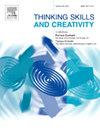评估人工智能辅助的创造性思维:高等教育中的交叉研究
IF 4.5
2区 教育学
Q1 Social Sciences
引用次数: 0
摘要
随着人工智能(AI)越来越多地融入教育环境,它对学生创造性思维的影响尚不清楚。鉴于创造力在工程和设计教育中的关键作用,了解人工智能工具如何塑造学生的思维过程对于开发有效的教学实践至关重要。本研究考察了生成式人工智能,特别是ChatGPT对设计工程本科学生创造性思维的影响。这项研究是通过随机交叉实验进行的,学生们在人工智能辅助和无辅助的思维任务之间交替进行。一种混合方法结合了对产生的728个想法的定量分析和对学生与人工智能互动的定性评估。结果表明,人工智能的使用不会降低流畅性、灵活性或独创性,也不会导致主题同质化。然而,在人工智能辅助条件下,语义分歧明显降低,这表明思想的形成方式趋同。此外,人工智能辅助的想法更频繁地与现有产品相似,并且表现出较少的文本阐述。一项混合的被试间方差分析显示,从人工智能支持开始的学生在两项任务中都产生了更多原创和多样化的想法,这表明早期使用人工智能的影响是持久的。对学生与人工智能互动的定性分析揭示了重要的模式,包括主要是被动和指导性的使用,以及有限的探索性或协作性参与。这些发现为人类与人工智能的共同创造提供了新的见解,并强调了在教育中促进有意、批判性和教学指导下使用生成式人工智能工具的重要性。本文章由计算机程序翻译,如有差异,请以英文原文为准。
Evaluating AI-assisted creative ideation: A crossover study in higher education
As artificial intelligence (AI) becomes increasingly integrated into educational contexts, its impact on students’ creative thinking remains unclear. Given the critical role of creativity in engineering and design education, understanding how AI tools shape students’ ideation processes is essential for developing effective pedagogical practices. This study examines the impact of generative AI, specifically ChatGPT, on creative ideation among undergraduate design engineering students. The research was conducted through a randomised crossover experiment, with students alternating between AI-assisted and unaided ideation tasks. A mixed-methods approach combined quantitative analyses of the 728 ideas generated with a qualitative evaluation of students’ interactions with AI. Results show that the use of AI did not reduce fluency, flexibility, or originality, nor did it lead to thematic homogenisation. However, semantic divergence was significantly lower in the AI-assisted condition, suggesting convergence in the way ideas were formulated. Additionally, AI-assisted ideas more frequently resembled existing products and exhibited reduced textual elaboration. A mixed between-within subjects ANOVA revealed that students who began with AI support produced more original and diverse ideas across both tasks, pointing to a lasting effect of early AI use. Qualitative analysis of student-AI interactions revealed important patterns, including predominantly passive and directive use, with limited exploratory or collaborative engagement. These findings provide new insights into human-AI co-creation and highlight the importance of promoting intentional, critical, and pedagogically guided use of generative AI tools in education.
求助全文
通过发布文献求助,成功后即可免费获取论文全文。
去求助
来源期刊

Thinking Skills and Creativity
EDUCATION & EDUCATIONAL RESEARCH-
CiteScore
6.40
自引率
16.20%
发文量
172
审稿时长
76 days
期刊介绍:
Thinking Skills and Creativity is a new journal providing a peer-reviewed forum for communication and debate for the community of researchers interested in teaching for thinking and creativity. Papers may represent a variety of theoretical perspectives and methodological approaches and may relate to any age level in a diversity of settings: formal and informal, education and work-based.
 求助内容:
求助内容: 应助结果提醒方式:
应助结果提醒方式:


